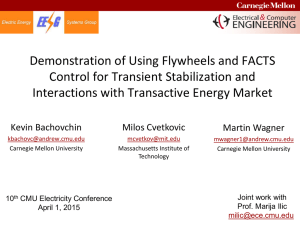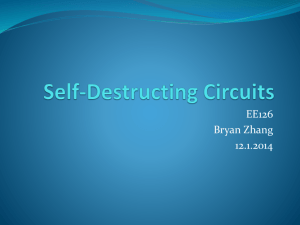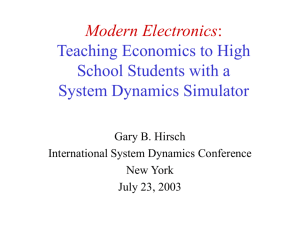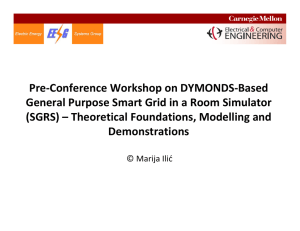Example of SGRS Implementation for Cooperative Transient Stabilization Using FACTS
advertisement
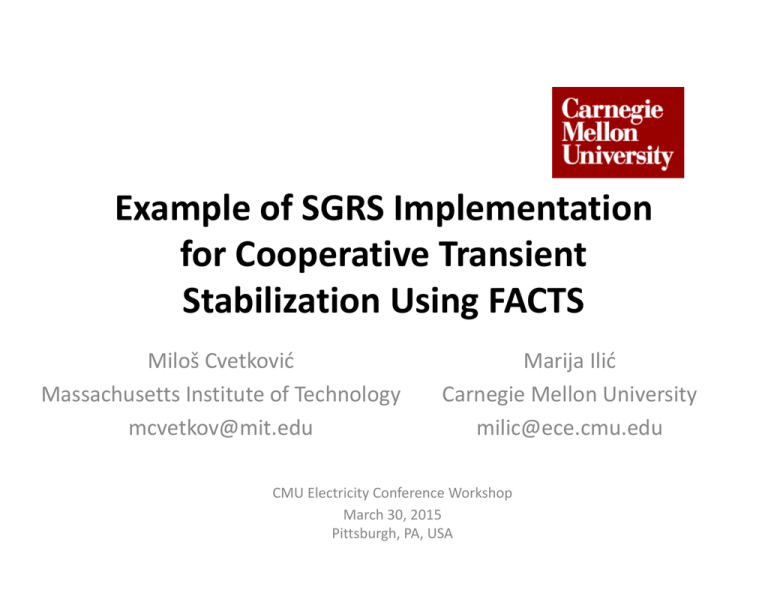
Example of SGRS Implementation for Cooperative Transient Stabilization Using FACTS Miloš Cvetković Massachusetts Institute of Technology mcvetkov@mit.edu Marija Ilić Carnegie Mellon University milic@ece.cmu.edu CMU Electricity Conference Workshop March 30, 2015 Pittsburgh, PA, USA In this talk Implications for SGRS distributed integration of differential equations Large scale interconnected power system Transient stability problem Unstable Stable Interactions are captured using an energy‐based model Cooperative power electronics (FACTS) control 2 Need for Smarter Control • • • • Benefits to system operators: Safer integration of volatile renewables and unanticipated demand behavior Improved efficiency and reliability by improving dynamic performance Controlled dynamical interactions between devices • • • Benefits to manufacturers of power electronics: Safe and reliable operation of devices Deployment for system‐wide stability improvement 3 Today’s Practice for Ensuring Transient Stability • Off‐line stability assessment • Special protection schemes Compute generation set‐points Economic dispatch Transient stability assessment Unsatisfying stability margin • Tuning controllers locally Implement generation set‐points • What is missing? 1. Conservative controller design 2. Interactions are not captured when designing controllers 3. Use of power electronics as controllers in mesh grid topologies 4 Proposed Approach • Use line‐flow power electronics as controllers because of – Fast thyristor switching (fast response time) – Potential to manage flows in the grid • Energy‐based modeling to capture interactions between FACTS and generators • Tune controllers considering interactions • Ectropy‐based controller to redirect flows of energy in the grid • SGRS module implementation using interaction‐based models 5 A Comprehensive Power System Model Generators are modeled using 7th order model: ‐ Stator current (D,Q) ‐ Rotor currents (D,Q,F) ‐ Rotor position angle ‐ Mechanical frequency Loads are modeled as constant power loads All states are described in the time‐varying phasor domain Transmission lines are modeled using a PI model: ‐ Line current (D,Q) ‐ Bus voltage (D,Q) TCSC is modeled as an inductor and a capacitor in parallel: ‐ Inductor current (D,Q) ‐ Capacitor voltage (D,Q) 6 Extracting Time Scale of Interest • Singular perturbation is used to simplify the power system model Corresponding states and time constants , , , , , Time scale of interest 0 0 7 Reduced Order Model for Transient Stability , , , , , , 8 Reduced Order Model for Transient Stability Modular Form , , A practical concern: Control signals , are, in general, functions of all system states , , , , , 9 Introducing Interaction Variables , → , Solution: Accumulated energies states of the model (interaction variables) , , as ̅ , Accumulated energy interaction variable → , , ̅ M. Cvetkovic, M. Ilic, “A Two-level Approach to Tuning FACTS for Transient Stabilization”, IEEE PES General Meeting, July 2014. From physical state space to energy state space 10 A Two‐level Model Using Interaction Variables ̅ ̅ ̅ , ̅ , ̅ , ̅ , This model separates internal device dynamics from dynamics of its interactions , , → ̅ , , Interaction level dynamics Internal level dynamics ̅ ̅ ̅ , ̅ , , ̅ , ̅ , , M. Cvetkovic, M. Ilic, “A Two-level Approach to Tuning FACTS for Transient Stabilization”, IEEE PES General Meeting, July 2014. → ̅ , , 11 Proposed Cooperative Controller • Redistribute energy of disturbance Generator Generator FACTS FACTS Accumulated (stored) energy in an uncontrolled system Accumulated (stored) energy in a system controlled by power electronics Cooperative control is expressed in terms of higher (interaction) level dynamics. M. Cvetkovic, M. Ilic, “Ectropy-based Nonlinear Control of FACTS for Transient Stabilization”, IEEE Transactions on Power Systems, Vol. 29, No. 6, November 2014, pp. 3012-3020. Control Objective at the Slower Time Scale ̅ ̅ ̅ , ̅ , , Stabilize interaction variable of the generators module using ectropy , , 1 2 ∗ ∗ ̅ , , 1 → ∗ ̅ , , ̅ Power exchanged at the slower time scale ̅ ̅ , ̅ , ̅ , , M. Cvetkovic, M. Ilic, “Cooperative Line-flow Power Electronics Control for Transient Stabilization”, IEEE Conference on Decision and Control, December 2014. , 0 0 0 Assume instantaneous dynamics of power electronics 13 Control Logic at the Faster Time Scale Assume slow generator interaction and states Track the power reference obtained from the ectropy stabilization problem ̅ 1 2 ̅ , , 1 ̅ Power exchanged at the faster time scale ̅ ̅ , ̅ , , , , → ̅ , 0 , M. Cvetkovic, M. Ilic, “Cooperative Line-flow Power Electronics Control for Transient Stabilization”, IEEE Conference on Decision and Control, December 2014. 14 Numerical Implementation for SGRS 1 ̅ ̅ ̅ , ̅ , , , ̅ ̅ , ̅ , , step evolves at rate , step 1 ̅ , , ̅ at the same rate as ̅ evolves at rate 1 , ̅ , ̅ fast compared to ̅ ̅ , ̅ ̅ , ̅ , , 1 , , ̅ 1 evolve at rate ̅ ̅ 1 ̅ , ̅ 1 / , , , step , , / 1 15 Numerical Integration Flow Chart Generator Initialize , ̅ and 1 , FACTS Initialize , ̅ and 0 0 1 no Integrate and ̅ with step no yes Integrate with step End simulation no yes yes 0 1 Integrate ̅ with step 0 Compute and communicate Compute and communicate SGRS Implementation 1 Generator Initialize Start simulation , ̅ and FACTS Initialize Start simulation , ̅ and 0 0 Integrate ̅ with step Compute new state of the module no no yes Integrate with step End simulation no yes yes Integrate and ̅ with step Compute new state of the module Write( , ) Compute and communicate Read( , 1) no Write( , ) Compute and Read( , 1) communicate yes End simulation Response of Uncontrolled System Short circuit at bus 3 in duration of 0.35 sec 18 Controlled System Response 1 0 FACTS energy has reached zero States converge to a different equilibrium 19 Conclusions • A two‐level approach to power system modeling lends itself to: – Cooperative control design for power electronics – Time scale separation for reduced communication rate • Open questions: – Sensitivity to time scale overlap – Shortest communication rate between any two modules constrains the simulation – Selection of modules for control purposes 20
